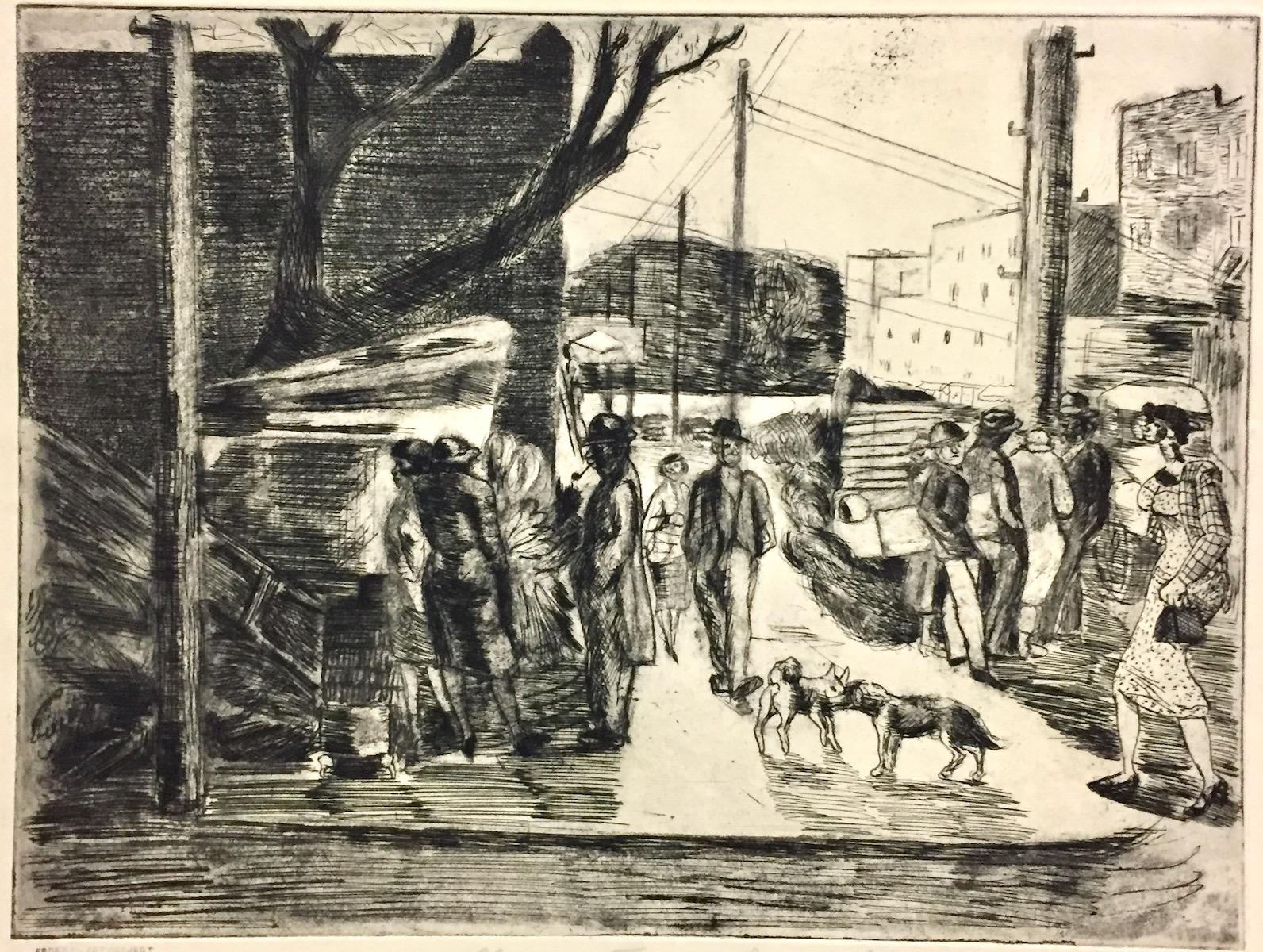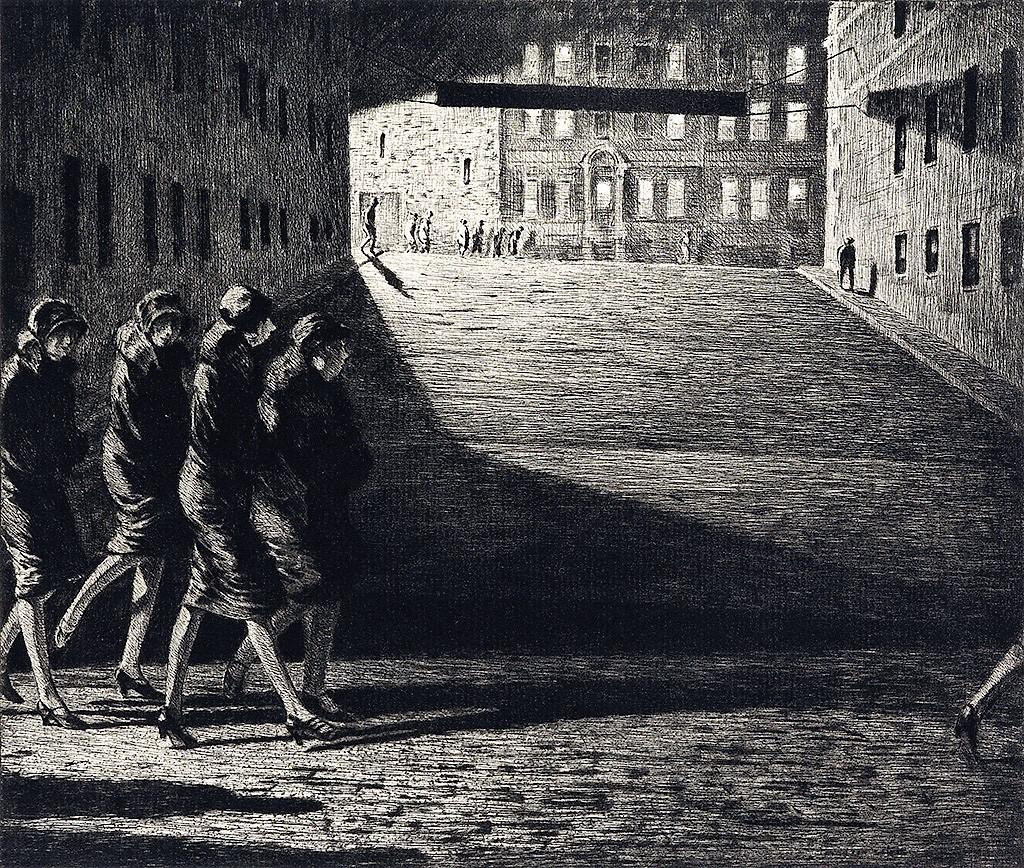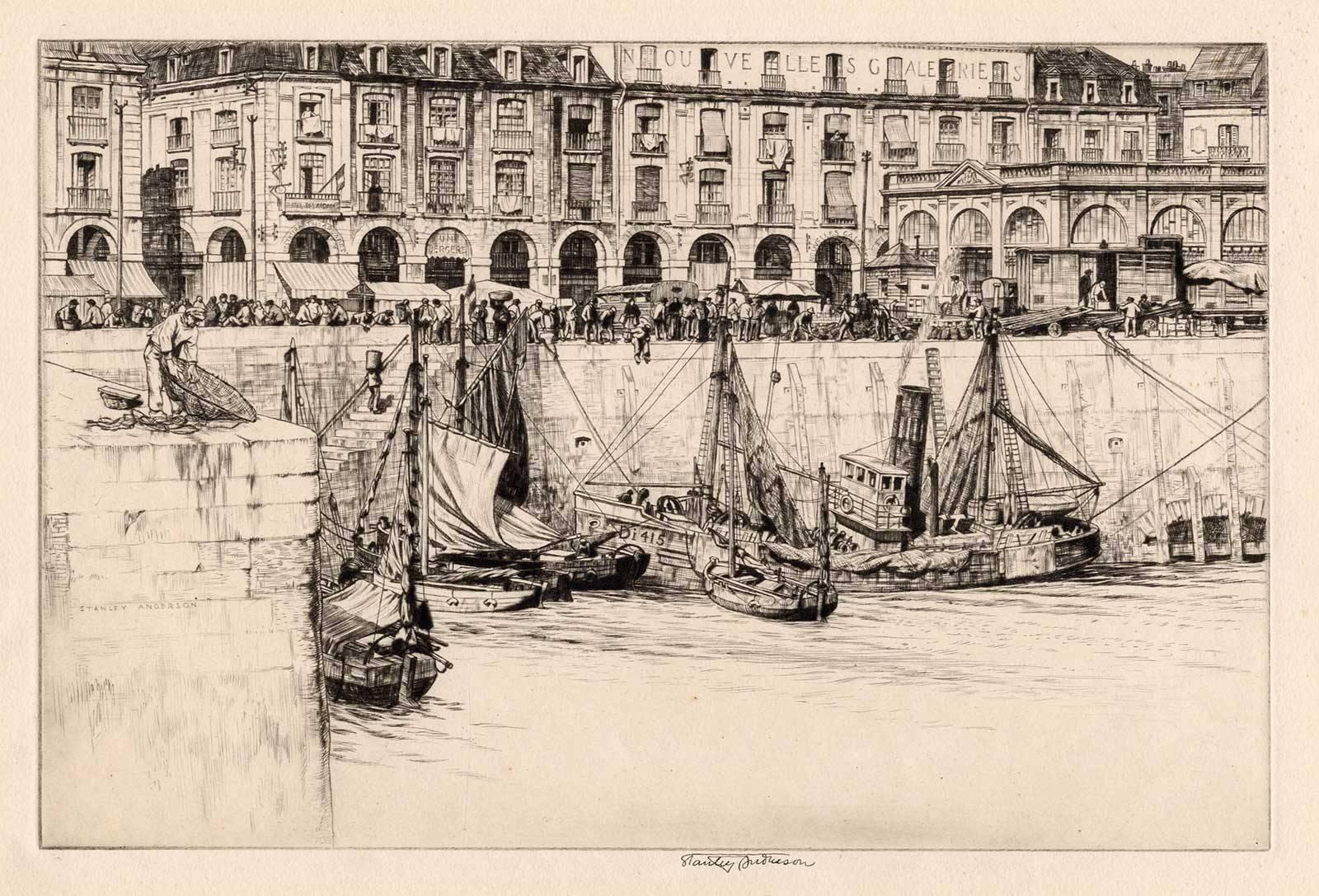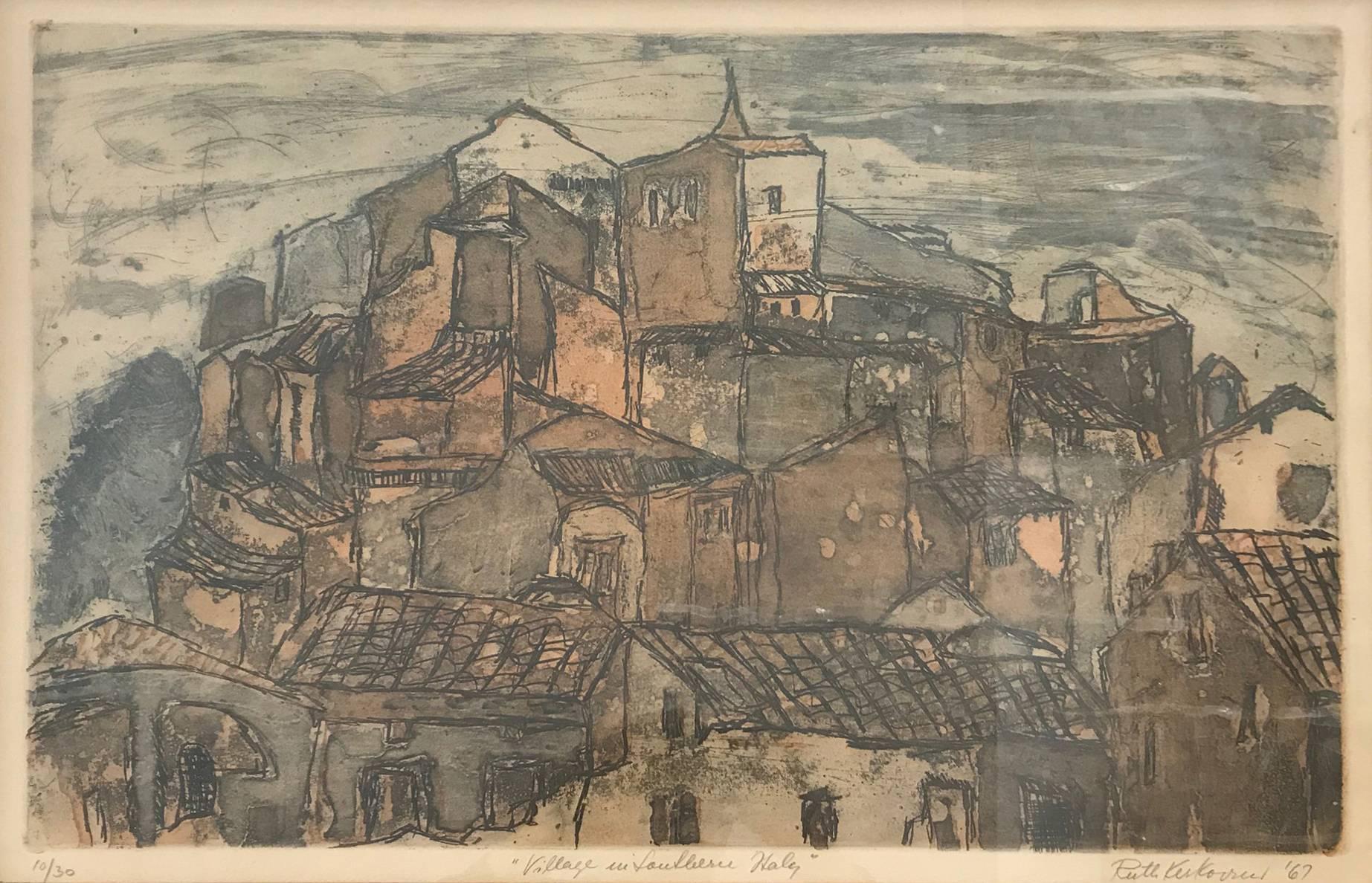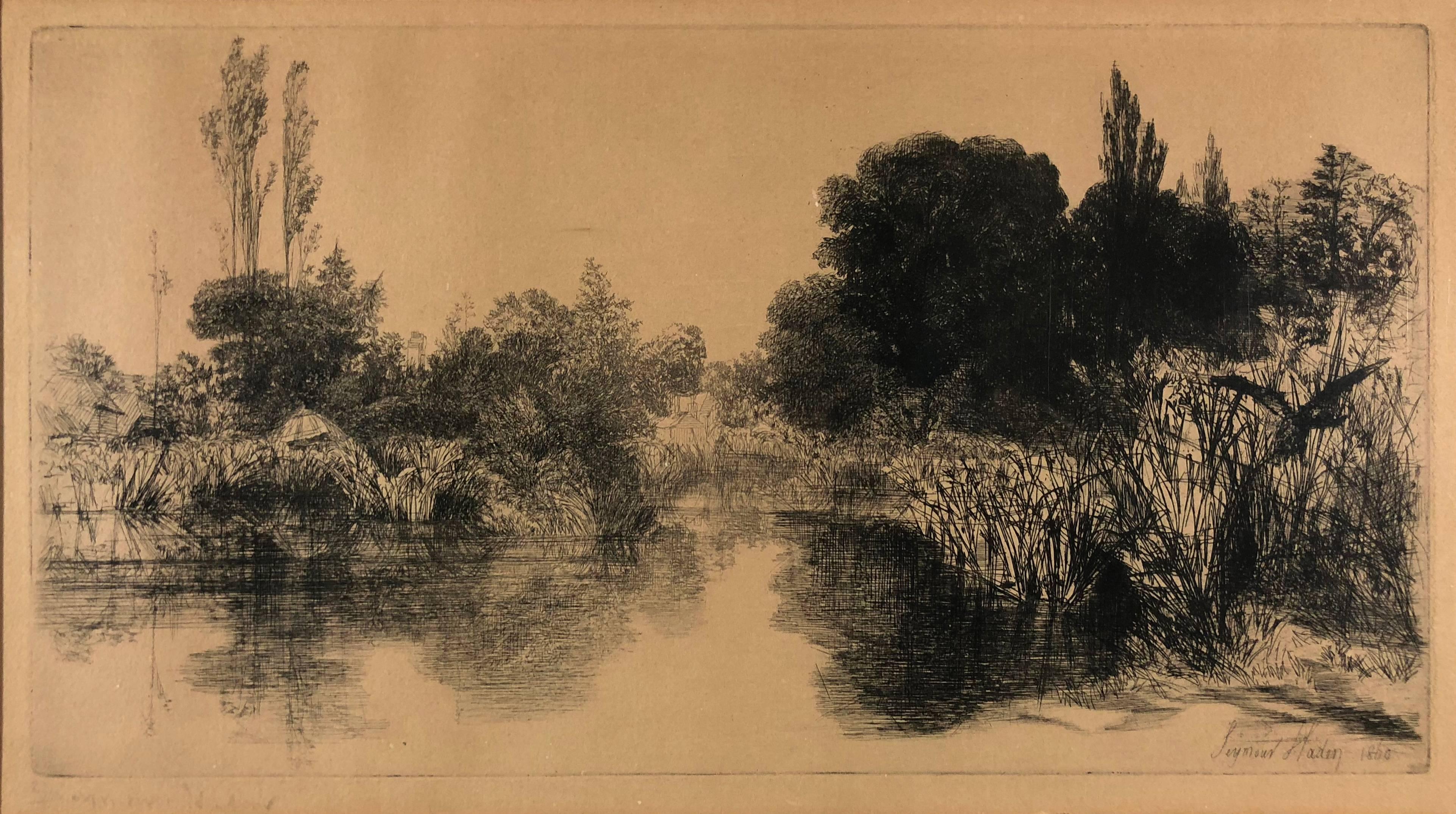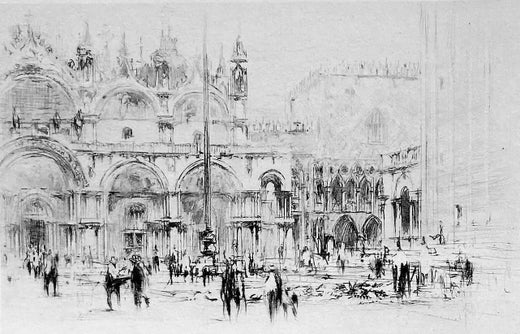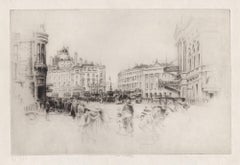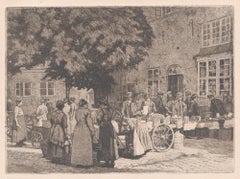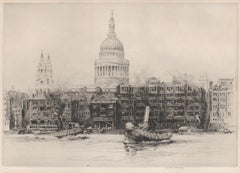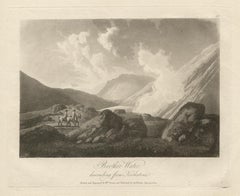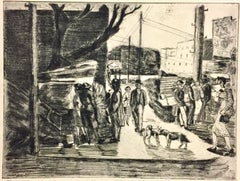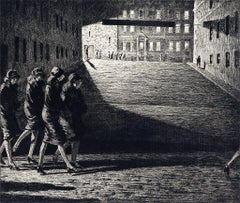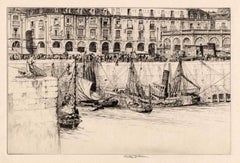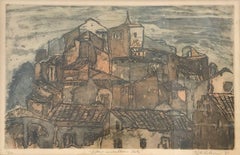Items Similar to Brooklyn Bridge, New York, signed etching by William Walcot, c1925
Want more images or videos?
Request additional images or videos from the seller
1 of 6
William Walcot R. E. Hon. R. I. B. A.Brooklyn Bridge, New York, signed etching by William Walcot, c1925Circa 1925
Circa 1925
About the Item
Signed in pencil by the artist lower right. William Walcot was born in Russia and moved to London in 1907. He trained and practiced as an architect before devoting himself to architectural etching. He is works are highly regarded.
215mm by 250mm (platemark)
310mm by 390mm (sheet)
- Creator:William Walcot R. E. Hon. R. I. B. A. (1874 - 1943, British)
- Creation Year:Circa 1925
- Dimensions:Height: 12.21 in (31 cm)Width: 15.36 in (39 cm)
- Medium:
- Movement & Style:
- Period:
- Condition:Acid burn from previous mount just outside the platemark and going through the bottom of the pencil signature. Pencil inscriptions at the very bottom of the sheet.
- Gallery Location:Melbourne, AU
- Reference Number:1stDibs: LU124428768362
William Walcot R. E. Hon. R. I. B. A.
When he was seventeen, William Walcot began to study architecture under Louis Benois at the Imperial Academy of Art in Saint Petersburg. He went to Paris where he continued his studies at the Ecole des Beaux-Arts and the Atelier Redon. He practiced as an architect briefly in Moscow, designing the Hotel Metropole in 1898. In 1907, Walcot settled in London where he was employed as a draughtsman by the South-African-born architect, Eustace Frere. In 1933, Walcot designed one London building, 61 St. James Street, but his main architectural activity was that of a freelance draughtsman. He produced drawings and etchings for architects to show their clients and to exhibit at the Royal Academy summer exhibitions. Throughout the 1920s and 1930s, Walcot was the most celebrated architectural draughtsman in England, enhancing the scale and drama of the buildings he depicted with his mastery of techniques including watercolor and gouache.
About the Seller
5.0
Vetted Professional Seller
Every seller passes strict standards for authenticity and reliability
Established in 2005
1stDibs seller since 2019
570 sales on 1stDibs
Typical response time: 1 hour
- ShippingRetrieving quote...Shipping from: Melbourne, Australia
- Return Policy
Authenticity Guarantee
In the unlikely event there’s an issue with an item’s authenticity, contact us within 1 year for a full refund. DetailsMoney-Back Guarantee
If your item is not as described, is damaged in transit, or does not arrive, contact us within 7 days for a full refund. Details24-Hour Cancellation
You have a 24-hour grace period in which to reconsider your purchase, with no questions asked.Vetted Professional Sellers
Our world-class sellers must adhere to strict standards for service and quality, maintaining the integrity of our listings.Price-Match Guarantee
If you find that a seller listed the same item for a lower price elsewhere, we’ll match it.Trusted Global Delivery
Our best-in-class carrier network provides specialized shipping options worldwide, including custom delivery.More From This Seller
View AllPiccadilly Circus, London, etching by Frederick Farrell, circa 1920
Located in Melbourne, Victoria
Signed in pencil below the image by the artist. Blind stamps of etching societies lower left just under the image.
Frederick Farrell was a Scottish etcher specializing in architectu...
Category
1920s Other Art Style Landscape Prints
Materials
Drypoint, Etching
Street Market - Montmatre, France, etching, 1922
Located in Melbourne, Victoria
Monogram and date of etching in the plate bottom left.
220mm by 305mm (platemark) 310mm by 390mm (sheet)
Category
1920s Art Nouveau Landscape Prints
Materials
Drypoint, Etching
St Paul's Cathedral, Thames, London, etching by Frederick Farrell, circa 1920
Located in Melbourne, Victoria
Signed in pencil below the image by the artist. Blind stamps of etching societies lower left just under the image.
Frederick Farrell was a Scottish etcher specializing in architectu...
Category
1920s Other Art Style Landscape Prints
Materials
Drypoint, Etching
Brother Water, Lake District scenery C19th English aquatint
Located in Melbourne, Victoria
'Brother Water descending from Kirkstone'
Aquatint by William Green, 1804
William Green of Ambleside was a Lake District draughtsman, soft ground etch...
Category
Early 19th Century Naturalistic Landscape Prints
Materials
Engraving, Aquatint
Falcon Crag, Lake District scenery C19th English aquatint
Located in Melbourne, Victoria
'Falcon Crag'
Aquatint by William Green, 1804
William Green of Ambleside was a Lake District draughtsman, soft ground etcher and aquatint engraver of ...
Category
Early 19th Century Naturalistic Landscape Prints
Materials
Engraving, Aquatint
Italianate Landscape, mezzotint by Richard Earlom after Claude le Lorrain
By (after) Claude Lorrain (Claude Gellée)
Located in Melbourne, Victoria
Sepia mezzotint by Richard Earlom (1743-1822) After Claude Gellee ('Claude Lorrain') (1600-82).
From 'Liber Veritatis; or A Collection of Prints after the original designs of Claude le Lorrain...
Category
Late 18th Century Italian School Landscape Prints
Materials
Engraving, Mezzotint, Etching
You May Also Like
Irving Guyer, Christmas Trees on Second Street (NYC)
By Irving Guyer
Located in New York, NY
Philadelphia-born Irving Guyer attended the Art Students League and worked in New York City before moving to California. This print is signed and titled i...
Category
1930s American Modern Figurative Prints
Materials
Drypoint, Etching
Shadows on the Ramp
By Martin Lewis
Located in Storrs, CT
Shadows on the Ramp. 1927. Drypoint and sand ground. McCarron 64. 9 x 10 1/2 (sheet 12 3/8 x 14). Edition 75 recorded impressions. A rich, tonal impression with drypoint burr, printe...
Category
1920s American Modern Landscape Prints
Materials
Drypoint, Etching
Les Arcades, Dieppe France (the arches along coastline of a town in Normandy)
By Stanley Anderson
Located in New Orleans, LA
The image show a panoramic view of the architectural arches and the boats in the harbor of Dieppe in Normandy France. Dieppe was occupied by German naval and army forces after the f...
Category
Early 20th Century Modern Landscape Prints
Materials
Drypoint, Etching
Village in Southern Italy (Edition 10/30)
By Ruth Kerkovius
Located in New York, NY
Ruth Kerkovius (Latvian/American 1921-1970) "Village in Southern Italy" Edition 10/30, Landscape Etching/Drypoint/Aquatint signed and numbered in Pencil, 16.25 x 24.75, Late 20th Century, 1967
Colors: Black, Brown, Blue, White, Red
She was born in Latvia in 1921. She received her early training in Munich, Germany, working in theatre Costume History and Design, and in painting before she came to America.
Once in New York she studied at the Art Students League, the School of Visual Arts, the Pratt Graphic Art Center under Frasconi, and then continued at Pratt on a fellowship to work under Michael Ponce de Leon...
Category
1960s Abstract Abstract Prints
Materials
Drypoint, Etching, Aquatint
Shere Mill Pond
By Sir Francis Seymour Haden, R.A.
Located in Missouri, MO
Shere Mill Pond, No. II (large plate). 1860. Etching and drypoint. Schneiderman 37.v/ix. 7 x 13 1/8 (sheet 10 3/4 x 16 3/8). This state is prior to publication in Études à l'Eau-Forte. Illustrated: Keppel The Golden Age of Engraving; Print Collector's Quarterly 1 (1911): 18; : Guichard, British Etchers, 1850-1940. A rich, brilliant proof with drypoint burr printed on white laid paper. Signed in pencil.
-------------------------------------------------------------------------------------------
Shere Mill Pond, No. II was one of the most highly praised landscape prints of the etching revival. An impression was exhibited at the Royal Academy in 1861 under Haden’s pseudonym, H. Dean. Francis Seymour Haden used this anagram of his own name early in his career as an artist, in order to retain his anonymity and preserve his professional reputation as a surgeon.
Biography:
Sir Francis Seymour Haden (16 September 1818 - 1 June 1910), was an English surgeon, best known as an etcher.
He was born in London, his father, Charles Thomas Haden, being a well-known doctor and lover of music. He was educated at Derby School, Christ's Hospital, and University College, London, and also studied at the Sorbonne, Paris, where he took his degree in 1840. He was admitted as a member of the College of Surgeons in London in 1842.
In 1843-1844, with his friends Duval, Le Cannes and Colonel Guibout, he travelled in Italy and made his first sketches from nature. Haden attended no art school and had no art teachers, but between 1845 and 1848 he studied portfolios of prints belonging to a second-hand dealer named Love, who had a shop in Bunhill Row, the old Quaker quarter of London. Arranging the prints in chronological order, he studied the works of the great original engravers, Albrecht Dürer, Lucas van Leyden and Rembrandt. These studies, besides influencing his original work, led to his important monograph on the etched work of Rembrandt. By lecture and book, and with the aid of the memorable exhibition at the Burlington Fine Arts Club in 1877, he tried to give a true reflection of Rembrandt's work, giving a nobler idea of the master's mind by taking away from the list of his works many dull and unseemly plates that had long been included in the lists. His reasons were founded upon the results of a study of the master's works in chronological order, and are clearly expressed in his monograph, The Etched Work of Rembrandt critically reconsidered, privately printed in 1877, and in The Etched Work of Rembrandt True and False (1895).
Haden's printmaking was invigorated by his much younger brother-in-law, James Whistler, at the Haden home in Sloane Street in 1855. A press was installed there and for a while Haden and Whistler collaborated on a series of etchings of the Thames. The relationship and project did not last.
Haden followed the art of original etching with such vigour that he became not only the foremost British exponent of that art but brought about its revival in England. His strenuous efforts and perseverance, aided by the secretarial ability of Sir WR Drake, resulted in the foundation of the Royal Society of Painter-Etchers and Engravers. As president he ruled the society with a strong hand from its first beginnings in 1880.
Notwithstanding his study of the old masters of his art, Haden's own plates were very individual, and are particularly noticeable for a fine original treatment of landscape subjects, free and open in line, clear and well divided in mass, and full of a noble and dignified style of his own. Even when working from a picture his personality dominates the plate, as for example in the large plate he etched after J.M.W. Turner's "Calais Pier," which is a classical example of what interpretative work can do in black and white. Of his original plates, more than 250 in number, one of the most notable was the large "Breaking up of the Agamemnon."
An early plate, rare and most beautiful, is "Thames Fisherman". "Mytton Hall" is broad in treatment, and a fine rendering of a shady avenue of yew trees leading to an old manor-house in sunlight. "Sub Tegmine" was etched in Greenwich Park in 1859; and "Early Morning--Richmond", full of the poetry and freshness of the hour, was done, according to Haden, actually at sunrise. One of the rarest and most beautiful of his plates is "A By-Road in Tipperary"; "Combe Bottom" is another; and "Shere Mill Pond" (both the small study and the larger plate), "Sunset in Ireland," "Penton Hook," "Grim Spain" and "Evening Fishing, Longparish," are also notable examples of his genius. A catalogue of his works was begun by Sir William Drake and completed by Harrington in 1880. During later years Haden began to practise the sister art...
Category
Late 19th Century Old Masters Landscape Prints
Materials
Drypoint, Etching
Shere Mill Pond II (Large Plate)
By Seymour Haden
Located in New York, NY
Seymour Haden (1818-1910), Shere Mill Pond II (Large Plate), etching and drypoint, 1860, signed in pencil lower right [also signed in the plate lower right]. Schneiderman 37, sixth state (of 9). In generally good condition (see note below) with margins, on a cream/ivory laid paper, 7 x 13 1/2, the sheet 8 1/8 x 13 3/4 inches.
A very good impression, with rich burr especially in the reeds toward the right.
Provenance: Frederick Keppel and Co., New York, NY.
Illustrated: Guichard, British...
Category
1860s Impressionist Landscape Prints
Materials
Drypoint, Etching
